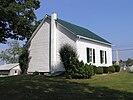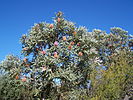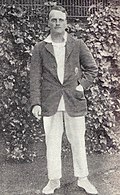Wikipedia:Today's featured article/October 2015
| << | Today's featured articles for October 2015 | >> | ||||
|---|---|---|---|---|---|---|
| Su | Mo | Tu | We | Th | Fr | Sa |
| 1 | 2 | 3 | ||||
| 4 | 5 | 6 | 7 | 8 | 9 | 10 |
| 11 | 12 | 13 | 14 | 15 | 16 | 17 |
| 18 | 19 | 20 | 21 | 22 | 23 | 24 |
| 25 | 26 | 27 | 28 | 29 | 30 | 31 |
October 1
The Gateway Protection Programme is operated by the British government in partnership with the United Nations High Commissioner for Refugees (UNHCR) and co-funded by the European Union, offering a legal route for a quota of UNHCR-identified refugees to settle in the United Kingdom. It was proposed by the British Home Secretary, David Blunkett, in October 2001, and its legal basis was established by the Nationality, Immigration and Asylum Act 2002. The programme launched in March 2004, initially with a quota of 500 and later 750 refugees per year, but the actual number of refugees resettled in most years has been fewer than the quota permitted. As of 2012, refugees of 12 different nationalities had been resettled, with the largest groups being Iraqis, Congolese, Ethiopians, Burmese and Somalis, and 18 of the UK's 434 local authorities had participated as resettlement locations. Evaluations of the programme have praised it as having a positive impact on the reception of refugees by local communities, but have also noted the difficulties these refugees have faced in securing employment. (Full article...)
October 2
Capon Chapel is a mid-19th-century church near the town of Capon Bridge in the US state of West Virginia. A Baptist congregation began gathering at the site of the present-day church as early as 1756. The land belonged to William C. Nixon, a member of the Virginia House of Delegates, and later to the extended family of Captain David Pugh of the West Virginia House of Delegates. Capon Chapel was used as a place of worship by Baptists until the late 19th or early 20th century, by the Southern Methodist Episcopal Church for most of the 20th century, and in this century by the United Methodist Church. The church cemetery contains the remains of John Monroe (one of the first ministers at the site), Nixon, Pugh, American Civil War veterans from the Union and the Confederacy, and free and enslaved African Americans. Capon Chapel, along with its cemetery, was added to the National Register of Historic Places in 2012 in recognition of its rural religious architecture representative of the Potomac Highlands region, and for its service as a rural church in Hampshire County. (Full article...)
October 3
Suillus brevipes is a species of fungus in the family Boletaceae. First described by American mycologists in the late 19th century, it is commonly known as the short-stemmed slippery Jack. The mushrooms produced by the fungus are characterized by a chocolate to reddish-brown cap covered with a sticky layer of slime, and a short whitish stalk without a partial veil. The cap can reach a diameter of about 10 cm (3.9 in), while the stalk is up to 6 cm (2.4 in) long and 2 cm (0.8 in) thick. Like other bolete mushrooms, S. brevipes produces spores in a vertically arranged layer of spongy tubes with openings that form a layer of small yellowish pores on the underside of the cap. The fungus grows on or near various species of two- and three-needled pines, especially lodgepole and ponderosa pine. It is found throughout North America, and has been introduced to several other countries via transplanted pines. The mushrooms are slimy but edible, and are good sources of the essential fatty acid linoleic acid. (Full article...)
October 4
George Formby Sr (1875–1921) was known as one of the greatest music hall performers of the early 20th century. His comedy and songs played upon Lancashire stereotypes, and he was popular around Britain. His nickname, "The Wigan Nightingale", was coined because of the way he would use his bronchial cough as a comedic device. Born into poverty, he sang on street corners before starting a professional career in the 1890s, when he built up a following in Lancashire. He also developed a series of stage characters, including that of "John Willie", an accident-prone northerner. Formby had a successful recording career and made the transition from music hall to revue in 1916. He suffered from tuberculosis, and a stage accident in 1916 weakened him further; after he contracted influenza in the 1918 pandemic, he died in 1921 at the age of 45. Formby's act, and one of his costumes, inspired Charlie Chaplin to create the Tramp, his signature film character. Formby's son used parts of his father's act when starting his stage career and, once established, also changed his name to George Formby; he went on to become the top British male star in box office takings between 1937 and 1943. (Full article...)
October 5
Hurricane Gert was a large tropical cyclone that caused extensive flooding throughout Central America and Mexico in September 1993. It originated over the southwestern Caribbean Sea and briefly attained tropical storm strength before crossing Nicaragua, Honduras, and the Yucatán Peninsula. Once over warm water in the Bay of Campeche, Gert grew into a Category 2 hurricane and made landfall on the Gulf Coast of Mexico. The cyclone quickly weakened to a depression over the rugged terrain and eventually dissipated over the Pacific Ocean. Gert's broad wind circulation produced heavy rain across Central America, flooding property and crops. Although the highest winds occurred upon landfall in Mexico, the worst effects there were due to extreme rainfall of 31.41 inches (798 mm) over the mountains. Following the overflow of several rivers, expansive parts of the Huasteca region became submerged, forcing tens of thousands to evacuate. Roads across the affected countries were severely disrupted, and thousands became homeless. The disaster killed 116 people, left 16 missing, and caused $170 million in damage. (Full article...)
October 6
John Lloyd Waddy (1916–1987) was a senior officer and aviator in the Royal Australian Air Force, who later served as a member of the New South Wales Legislative Assembly and Minister of the Crown. As a fighter pilot during World War II, he shot down fifteen enemy aircraft in the Desert War, becoming one of Australia's top-scoring aces and earning the Distinguished Flying Cross. He went on to command No. 80 Squadron in the South West Pacific, where he was awarded the US Air Medal. He was also one of eight senior pilots who took part in the "Morotai Mutiny" of April 1945. He led the Air Force Reserve as a group captain in the early 1950s. Active in business and in veterans' groups, he was appointed an Officer of the Order of the British Empire in 1955. As the Liberal Member for Kirribilli from 1962 to 1976, he held cabinet posts in the New South Wales Parliament, including Minister for Child Welfare and Social Welfare (later Youth and Community Services), Minister for Health, and Minister for Police and Services. (Full article...)
October 7
Hu Zhengyan (c. 1584 – 1674) was a Chinese artist, printmaker and publisher. He worked in calligraphy, painting, and seal-carving (his own seal pictured), but was primarily a publisher, producing academic texts and records of his work. Hu lived in Nanjing during the transition from the Ming dynasty to the Qing dynasty. A Ming loyalist, he designed the Hongguang Emperor's personal seal and was offered a position at the emperor's remnant court, but declined the post, and held only minor political offices. He largely retired from society after the emperor's capture and death in 1645. He owned and operated an academic publishing house called the Ten Bamboo Studio in Nanjing, where he practised various multi-colour printing and embossing techniques. Hu's work pioneered new techniques in colour printmaking, producing delicate gradations of colour not previously achievable. He is best known for The Ten Bamboo Studio Manual of Painting and Calligraphy, an artist's primer which remained in print for around 200 years. (Full article...)
October 8
Shinano was an aircraft carrier built by the Imperial Japanese Navy during World War II, the largest one built up to that time. Laid down in May 1940 as the third of the Yamato-class battleships, the ship's partially complete hull was ordered to be converted to a carrier following Japan's disastrous loss of four fleet carriers at the Battle of Midway in mid-1942. Her conversion was still incomplete in November 1944 when she was ordered to sail from the Yokosuka Naval Arsenal to Kure Naval Base to complete her fitting out and to transfer a load of 50 Yokosuka MXY7 Ohka rocket-propelled kamikaze flying bombs. Hastily dispatched with an inexperienced crew and serious design and construction flaws, the ship had inadequate pumps, no fire-control systems, and no carrier aircraft. She was sunk en route, just 10 days after commissioning, on 29 November 1944, by four torpedoes from the US Navy submarine Archerfish. Over a thousand sailors and civilians were rescued, but some 1,435 were lost, including her captain. She remains the largest warship ever sunk by a submarine. (Full article...)
Part of the Yamato-class battleships featured topic.
October 9
Banksia menziesii, commonly known as firewood banksia, is a species of flowering plant in the genus Banksia. It is a gnarled tree up to 10 m (33 ft) tall or, in its northern range, a spreading shrub. The serrated leaves are dull green with new growth a paler grey green. The autumn and winter inflorescences are often two-coloured red or pink and yellow. First described by the botanist Robert Brown in the early 19th century, no separate varieties of B. menziesii are recognised. It is found in Western Australia, from the Perth region north to the Murchison River, and generally grows on sandy soils in scrubland or low woodland. It provides food for an array of invertebrate and vertebrate animals; honeyeaters and other birds are prominent visitors. A relatively hardy plant, B. menziesii is commonly seen in gardens, nature strips and parks in Australian urban areas with Mediterranean climates, but its sensitivity to root rot makes it short-lived in places with humid summers. It is widely used in the cut flower industry in Australia and overseas. (Full article...)
October 10
Business US Highway 41 was a state trunkline highway and business loop off US 41/M-28 in Marquette, Michigan, along Washington and Front streets. These two streets originated with the founding of the city in the mid-19th century, and served the downtown area; the original city hall was built in 1895 on Washington Street. In 1910 the city started paving its streets, replacing wooden planks with asphalt; later that decade, Washington and Front streets were included in the state highway system. In 1926 they were included in the United States Numbered Highway System. When US 41/M-28 was moved to bypass the downtown in 1963, Washington and Front streets were redesignated as a business loop. The highway was also co-designated Business M-28 on state maps between 1975 and 1981, mirroring a similar business loop designation in the neighboring cities of Ishpeming and Negaunee. Jurisdiction over the two streets was transferred to the city as part of a highway swap that resulted in the decommissioning of the trunkline in 2005. (Full article...)
Part of the M-28 featured topic.
October 11
The silky sifaka (Propithecus candidus) is a large lemur with silky white fur that lives in northeastern Madagascar. It is listed by the International Union for Conservation of Nature as one of the world's 25 most critically endangered primates. The silky sifaka lives in groups of two to nine and spends most of its day feeding, resting, playing, grooming, and traveling. Like other eastern sifakas, it eats leaves and seeds, but also fruit, flowers, and even soil. As with other sifaka species, group members will groom, play with, carry, and nurse infants that are not their own. Adults vocalize frequently despite having only seven different calls. Like all lemurs, it relies strongly on scent for communication; males frequently scent-mark. The species is found in the rainforests of northeastern Madagascar, with the remaining population in Marojejy National Park, Anjanaharibe-Sud Special Reserve, the Makira Forest Protected Area, the Betaolana Corridor, and some unprotected forest fragments. Locals hunt the silky sifaka throughout its range. (Full article...)
October 12
Charles Domery (c. 1778 – after 1800) was a soldier with an unusually large appetite. Serving in the Prussian Army during the War of the First Coalition, he deserted to the French Revolutionary Army in return for better rations. He was voraciously hungry; while stationed near Paris, he was recorded as having eaten 174 cats in a year, and would eat 4 to 5 pounds (1.8 to 2.3 kg) of grass each day if he could not find other food. During service on the French frigate Hoche, he attempted to eat the severed leg of a crew member hit by cannon fire, before it was wrestled from him. In 1799 Hoche was captured by British forces, and Domery and the crew were interned in Liverpool. Despite receiving ten times the rations of other inmates, he remained ravenous, eating the prison cat, at least 20 rats, and many prison candles. Domery's case was brought to the attention of the Sick and Hurt Commissioners, who tested his eating capacity by feeding him four bottles of porter and a total of 16 pounds (7.3 kg) of raw cow's udder, raw beef and tallow candles, all of which he ate and drank in a single day without defecating, urinating, or vomiting. (Full article...)
October 13
The Hastings Line is a secondary railway line in Kent and East Sussex, England, linking Hastings with the main town of Tunbridge Wells, and from there into London via Tonbridge and Sevenoaks. Although the line primarily carries passengers, a gypsum mine served by the railway is a source of freight traffic. Passenger trains on the line are operated by Southeastern. The railway was built by the South Eastern Railway in the early 1850s across the difficult terrain of the High Weald. Supervision was lax, and contractors skimped on the lining of the tunnels, causing deficiencies that showed up after the railway had opened. Rectifications included a restricted loading gauge along the line, requiring the use of specially made rolling stock. Served by steam locomotives from the time of opening until the late 1950s, passenger services were then taken over by a fleet of diesel-electric multiple units built to the line’s loading gauge. Freight was handled by diesel locomotives, also built to fit the loading gauge. The diesel-electric units were in service until 1986, when the line was electrified and the most severely affected tunnels were singled. (Full article...)
October 14
Mary Margaret O'Reilly (1865–1949) was the Assistant Director of the United States Bureau of the Mint. One of the highest-ranking female civil servants of her time, the "sweetheart of the Treasury" often served as the Mint's acting director in the absence of the director beginning in 1916, and was formally made assistant director in 1924. O'Reilly lived her early life in Massachusetts. She left school around age 14 to help support her widowed mother and her siblings, and worked in Worcester for twenty years as a clerk. In 1904, O'Reilly succeeded in gaining a position at the Mint Bureau. Her rapid rise in the hierarchy was unusual for a woman at that time, and with many of the directors under whom she served having little knowledge of or interest in the bureau's operations, the task of running the Mint often fell to her. Beginning in 1933, O'Reilly served under her first female director, Nellie Tayloe Ross, and soon forged a strong bond with her. O'Reilly was so indispensable to the bureau's operations that President Franklin Delano Roosevelt postponed her retirement, scheduled for 1935, to 1938. (Full article...)
October 15
"Lisa the Vegetarian" is the fifth episode of the seventh season of the animated series The Simpsons, originally aired on the Fox network in the United States on October 15, 1995. In the episode, Lisa Simpson stops eating meat after a trip to a petting zoo. Initially ridiculed by her family and friends for her decision, she commits to vegetarianism after advice from Apu and from Paul and Linda McCartney. The McCartneys guest-starred as themselves, appearing on condition that Lisa would remain a vegetarian for the rest of the series. The episode contains references to Paul's musical career, and his song "Maybe I'm Amazed" plays over the closing credits. Directed by Mark Kirkland, "Lisa the Vegetarian" is the first full episode of The Simpsons written by David X. Cohen. It was watched by 14.6 million viewers and received positive reviews from television critics. For its themes on animal issues, it won an Environmental Media Award and a Genesis Award. (Full article...)
October 16
On 16 October 1834 a major fire largely destroyed the Palace of Westminster, the medieval royal palace used as the home of the British parliament. The conflagration was caused by the burning of small wooden tally sticks that had been used as part of the accounting procedures of the Exchequer until 1826, which were being disposed of carelessly in the two furnaces under the House of Lords. The blaze caused a chimney fire, initially under the floor of the Lords' chamber, then up through the walls before spreading rapidly throughout the complex. The fire lasted for most of the night and developed into the biggest conflagration to occur in London between the Great Fire of 1666 and the Blitz of the Second World War; large crowds were attracted to the spectacle. By the following morning a large part of the palace had been destroyed, although the actions of the London Fire Engine Establishment ensured that Westminster Hall and a few other parts of the old Houses of Parliament survived. In 1836 a design competition for a new palace was won by Charles Barry who, in collaboration with Augustus Pugin, incorporated the surviving buildings into the new complex. (Full article...)
October 17
Roy Kilner (1890–1928) was an English professional cricketer who played nine Test matches for England between 1924 and 1926. He played for Yorkshire County Cricket Club between 1911 and 1927, scoring 1,000 runs in a season ten times and taking 100 wickets in a season five times. He first played for Yorkshire as a batsman before being wounded in the First World War. Returning in 1919 to a team short of bowlers, he developed into a proficient left-arm spinner. His aggressive batting and warm personality made him a popular player with both cricketers and spectators. First chosen for England in 1924, he was the second most successful bowler on the Ashes tour of 1924–25. He was selected during the 1926 Ashes series but dropped for the final Test. Kilner went on several coaching trips to India during English winters, and on one of these, in 1927–28, he contracted an illness; on his return to England, he died aged 37. His funeral was attended by over 100,000 people. (Full article...)
October 18
Deathrow is a sports video game developed by Southend Interactive and published by Ubisoft Entertainment. It was released as an Xbox gaming system exclusive in November 2002 in Europe and North America. Built on an in-house 3D game engine, it was Southend's first full release. Supporting up to eight players, the game is based on the fictional extreme sport Blitz, a futuristic full-contact hybrid of hockey and basketball played with a flying disc. Teams can win on points or by knocking opposing players unconscious. The single-player campaign is set in the 23rd century, when Blitz is a popular televised sport and the teams battle to scale the ranks and win the championship. The game's largely favorable reviews praised its fast-paced action and surround sound, but faulted its high difficulty curve, generic soundtrack, and lack of an online multiplayer mode. The game won the TeamXbox 2002 Breakthrough Game of the Year and the IGN 2002 Best Game Nobody Played awards. IGN later reported that a sequel would be unlikely due to the original's low revenue. Southend dissolved in 2013. (Full article...)
October 19
Banksia verticillata or Albany banksia is a species of shrub of the genus Banksia in the Proteaceae family. It is native to the southwest of Western Australia and can reach up to 3 m (10 ft) in height, or even 5 m (16 ft) in sheltered areas; it is shorter in more exposed areas. This species has elliptic green leaves and large, bright golden yellow flower spikes that appear in summer and autumn. The New Holland honeyeater (Phylidonyris novaehollandiae) is the most prominent pollinator although several other species of honeyeater, as well as bees, visit the flower spikes. Listed as a vulnerable species by the Australian Government, it occurs in two disjunct populations on granite outcrops along the south coast of Western Australia, with the main population near Albany and a smaller population near Walpole. It is threatened by root rot (specifically Phytophthora cinnamomi) and aerial canker (Zythiostroma). B. verticillata is killed by bushfire, following which new plants regenerate from seed. Populations take over a decade to produce seed, and fire intervals of more than twenty years are needed to allow the canopy seed bank to accumulate. (Full article...)
October 20
Luo Yixiu (1889–1910) was the first wife of the future Chinese communist revolutionary and political leader Mao Zedong, to whom she was married from 1908 until her death. She came from a family of impoverished Han Chinese landowners near Shaoshan, Hunan, in south central China. Most of what is known about their marriage comes from Mao and appears in the 1936 book Red Star Over China by the reporter Edgar Snow. The marriage was arranged by their fathers when Luo was eighteen and Mao was just fourteen. He later said that he was unhappy with the marriage, never consummating it and refusing to live with his wife. He moved out of the village to continue his studies elsewhere, eventually becoming a founding member of the Communist Party of China. Luo, socially disgraced, lived with Mao's parents for two years until she died of dysentery. Various biographers have suggested that this marriage affected Mao's later views, leading him to become a critic of arranged marriage and a vocal feminist. He would marry three more times, to Yang Kaihui, He Zizhen and Jiang Qing. (Full article...)
October 21
The Sci-Fi Dine-In Theater Restaurant is a theme restaurant at Disney's Hollywood Studios, a theme park at Walt Disney World in Bay Lake, Florida. The restaurant is modeled after a 1950s drive-in theater. Walt Disney Imagineering designed the booths to resemble convertibles of the period. While eating, guests watch a large projection screen displaying film clips from such films as Frankenstein Meets the Space Monster, Plan 9 from Outer Space, and Attack of the 50 Foot Woman. In 1991, the Sci-Fi Dine-In opened along with nineteen other new Walt Disney World attractions marking the complex's twentieth anniversary. By the following year, it had become the park's most popular restaurant. Thai movie theater operator EGV Entertainment opened the EGV Drive-in Cafe in Bangkok in 2003, explicitly emulating the Sci-Fi Dine-In. USA Today's list of the best restaurants in American amusement parks ranks the Sci-Fi Dine-In fifteenth, but many reviewers rate it more highly for its atmosphere than for its cuisine. (Full article...)
October 22
The common blackbird (Turdus merula) is a species of true thrush. It breeds in Europe, Asia, and North Africa, and has been introduced to Canada, the United States, Mexico, Peru, Brazil, Argentina, Uruguay, the Falkland Islands, Chile, South Africa, Australia and New Zealand. It has several subspecies across its large range; a few of the Asian subspecies are sometimes considered to be full species. Depending on latitude, the common blackbird may be resident, partially migratory, or fully migratory. The male of the nominate subspecies, which is found throughout most of Europe, is all black except for a yellow eye-ring and bill and has a rich, melodious song; the adult female and juvenile have mainly dark brown plumage. The species breeds in woods and gardens, building a neat, mud-lined, cup-shaped nest. It is omnivorous, eating a wide range of insects, earthworms, berries, and fruits. This common and conspicuous bird has given rise to many literary and cultural references, frequently related to its song. (Full article...)
October 23
United States v. Washington was a 1974 case heard in the U.S. District Court for the Western District of Washington and the U.S. Court of Appeals for the Ninth Circuit. It reaffirmed the reserved right of American Indian tribes in the State of Washington to act alongside the state as co-managers of salmon and other fish, and to continue harvesting them in accordance with the various treaties that the United States had signed with the tribes. The tribes of Washington had ceded their land to the United States but had reserved the right to fish as they always had (pictured), including fishing at their traditional locations that were off the designated reservations. After a long trial, the decision of federal judge George Hugo Boldt held that the tribes were entitled to half the fish harvest each year. In 1975 the Ninth Circuit Court of Appeals upheld Judge Boldt's ruling and the U.S. Supreme Court declined to hear the case. After the state refused to enforce the court order, Boldt ordered the Coast Guard to enforce his rulings. In a later case, Justice John Paul Stevens summarized: "Both sides have a right, secured by treaty, to take a fair share of the available fish." (Full article...)
October 24
Debora Green (b. 1951) is an American physician who pleaded no contest in 1995 to killing two of her children and trying to kill her husband, Michael Farrar. Their marriage had been tumultuous, and Farrar filed for divorce in July 1995. He soon fell violently ill, but his doctors could not pinpoint the source of his illness. Green began to drink heavily, even while supervising her children. In October the family home caught fire, and two of her children died in the blaze. Investigation showed that trails of accelerant in the house led back to Green's bedroom, and that she had been poisoning Farrar's food with ricin. The trial was sensational, and covered heavily by news media, especially in the Kansas–Missouri area, where the crimes occurred. She was sentenced to forty years in prison. Crime writer Ann Rule wrote about the case in her book Bitter Harvest: A Woman's Fury, a Mother's Sacrifice. Green has petitioned for a new trial twice in recent years, without success. (Full article...)
October 25
The three-cent silver was struck by the Mint of the United States for circulation from 1851 to 1872, and as a proof coin for collectors in 1873. A reduction of postage rates to three cents prompted Congress in 1851 to authorize the coin. At the time, profiteers were exporting and melting U.S. silver coins for their metal to trade for increasing amounts of gold in the wake of the California Gold Rush. The three-cent silver thwarted this scheme, as the first American coin with metal valued significantly less than its face value, and the first silver coin not usable as legal tender in unlimited amounts. Designed by the Mint's Chief Engraver, James B. Longacre, the coin saw heavy use until Congress protected other silver coins from profiteers in 1853 by reducing their silver content. The coin's place in commerce was lost with the economic chaos of the Civil War, which led to hoarding of all gold and silver coins. After the three-cent piece in copper-nickel emerged in 1865, the three-cent silver had a string of low mintages until its abolition by the Coinage Act of 1873. The series is not widely collected, and the pieces remain inexpensive relative to U.S. coins of similar scarcity. (Full article...)
October 26
Arthur Sifton (1858–1921) was the second Premier of Alberta from 1910 to 1917 and a minister in the Government of Canada thereafter. When Alberta was created out of a portion of the Northwest Territories in 1905, Sifton became its first chief justice. In 1910 the Alberta government of Premier Alexander Cameron Rutherford was embroiled in the Alberta and Great Waterways Railway scandal; Rutherford resigned, and the position was offered to Sifton. As premier, he failed to gain provincial control over natural resources, but succeeded in implementing some direct democracy measures, leading to prohibition and the extension of the vote to women. During the conscription crisis of 1917, Sifton supported the Conservative Prime Minister, Robert Borden, in his attempt to impose conscription to help win the First World War. He backed the creation of a Union government composed of Conservatives and pro-conscription Liberals. In 1917 he left provincial politics and became a minister in this government. Over the next three and a half years he served briefly in four ministries and was a delegate to the Paris Peace Conference of 1919. (Full article...)
October 27
Oerip Soemohardjo (1893–1948) was an Indonesian general and the first chief of staff of the Indonesian National Armed Forces. He trained in Batavia (modern-day Jakarta) to become a lieutenant in the Royal Netherlands East Indies Army, and after almost 25 years of service was the highest-ranking Native Indonesian officer in the country. He resigned in 1938, but was recalled to active duty after Nazi Germany invaded the Netherlands in May 1940. When the Empire of Japan occupied Indonesia less than two years later, he was detained in a prisoner-of-war camp for three and a half months. Indonesia proclaimed its independence from the Netherlands in 1945; several months later, he was declared the chief of staff and interim leader of the newly formed army. Working to build a united force from the fractured former military groups in the country, he oversaw army development during the Indonesian National Revolution along with General Sudirman, the leader of the armed forces. He has received several awards from the Indonesian government, including the title National Hero of Indonesia. (Full article...)
October 28
The Battle of Concepción was fought on October 28, 1835, between Mexican troops and Texian insurgents on the grounds of Mission Concepción (pictured in 2010), 2 miles (3.2 km) south of what is now Downtown San Antonio in the U.S. state of Texas. The day before, Stephen F. Austin, commander of the newly created Texian Army, had sent James Bowie, James Fannin, and 90 soldiers to find a defensible spot for the army to rest. After choosing a site near Mission Concepción, the scouting party camped for the night and sent a courier to notify Austin. Upon learning that the army was divided, General Martín Perfecto de Cos sent Colonel Domingo Ugartechea with 275 soldiers to attack the scouting party. The Texians took cover in a horseshoe-shaped gully; their good defensive position, longer firing range, and better ammunition helped them repel several attacks, and the Mexican soldiers retreated just 30 minutes before the remainder of the Texian Army arrived. Historians estimate that between 14 and 76 Mexican soldiers were killed, while only one Texian soldier died. (Full article...)
October 29
Telescopium is a minor constellation in the southern celestial hemisphere, one of twelve created in the 18th century by French astronomer Nicolas Louis de Lacaille and one of several depicting scientific instruments. Its name is a Latinized form of the Greek word for telescope. Telescopium was later much reduced in size by Francis Baily and Benjamin Gould. The brightest star in the constellation is Alpha Telescopii, a blue-white subgiant with an apparent magnitude of 3.5, followed by the orange giant star Zeta Telescopii at magnitude 4.1. Eta and PZ Telescopii are two young star systems with debris disks and brown dwarf companions. Telescopium hosts two unusual stars with very little hydrogen that are likely to be the result of merged white dwarfs: HD 168476, also known as PV Telescopii, is a hot blue extreme helium star, while RS Telescopii is an R Coronae Borealis variable. RR Telescopii is a cataclysmic variable that brightened to magnitude 6 in 1948 as a nova. (Full article...)
October 30
Fremantle Prison was built in Fremantle, Western Australia, between 1851 and 1859 using convict labour. Royal Commissions in 1898 and 1911 instigated some prison reforms, but after World War II, significant reforms lagged behind those occurring elsewhere in Australia and the world. Improvements in the late 1960s and early 1970s included an officer training school, social workers, welfare officers, and work release and community service programs. Punishments varied over the years, with flogging and leg irons eventually replaced by lengthening of sentences and restriction from visitors or entertainment. More than 40 hangings were carried out at Fremantle Prison, which was Western Australia's only lawful place of execution between 1888 and 1984. There were major riots in 1968 and 1988; in the second one, guards were taken hostage, and fire damage totalled $1.8 million (in 1988 Australian dollars). The prison closed in 1991, replaced by the new maximum-security Casuarina Prison. Since then, Fremantle Prison has become a tourist attraction and World Heritage Site. (Full article...)
October 31
Cucurbita (Latin for gourd) is a genus of vines in the gourd family, native to the Andes and Mesoamerica. Five species are grown worldwide, variously known as squash, pumpkin, or gourd depending on species, variety, and local parlance. The fruits have played a role in human culture for at least 2,000 years. First cultivated in the Americas before being brought to Europe by returning explorers, the plants remain an important food source. Most Cucurbita species are herbaceous vines that grow several meters in length and have tendrils, but bush cultivars of C. pepo and C. maxima have also been developed. Many North and Central American species are visited by honey bees, as well as specialist bees that pollinate only a single species. Most of the domesticated species can be considered winter squash, since the full-grown fruits can be stored for months. Their extracts have many uses, including in cosmetics for dry and sensitive skin. The fruits are also good sources of vitamins and minerals in foods such as pumpkin pie, biscuits, bread, desserts, puddings, beverages, and soups. (Full article...)


























